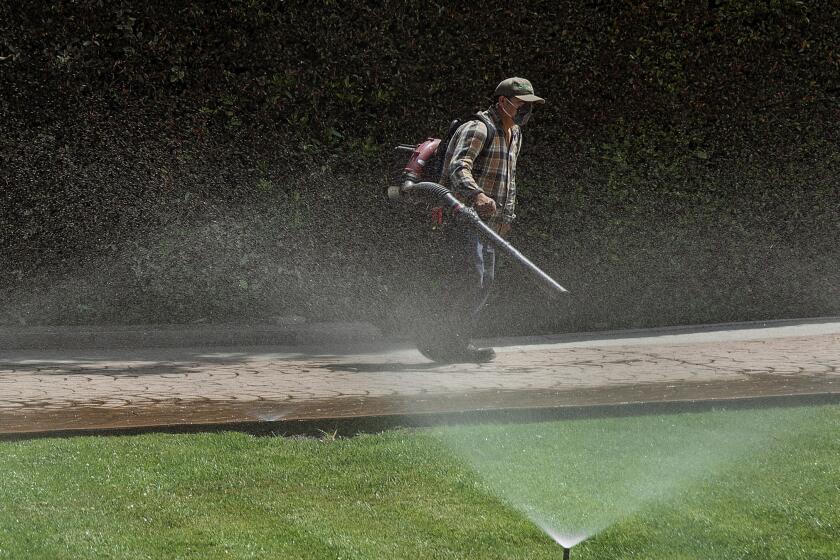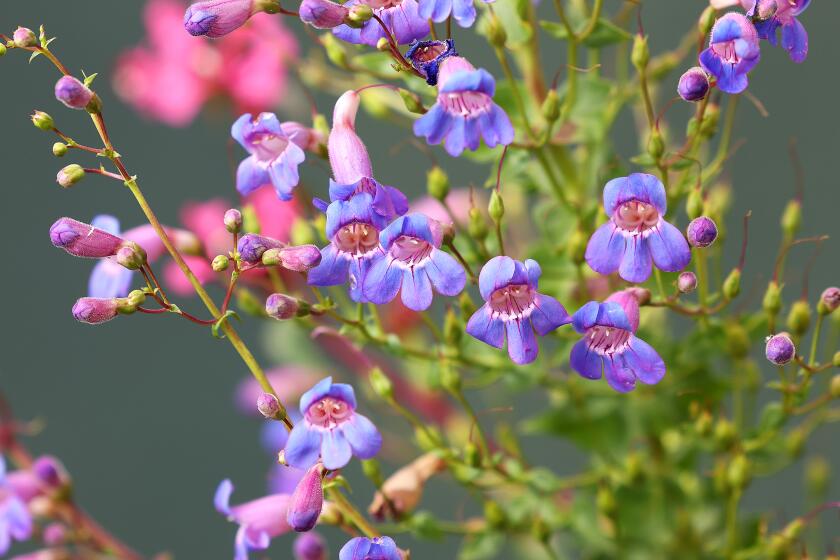Desert Islands : ‘Xeriscapers’ Say Method Saves Water--and Wallet’s Greenery
- Share via
From a distance, it looks like paradise:
Soft, rolling hills, rows of suburban ranch homes and a plethora of lawns. Large, expansive lawns, all immaculately maintained.
There’s just one problem--the lawns look a little too, well, green.
“We’re living in a desert,” said Lisa Iwata, a San Clemente landscape architect. “The greenery and lawns have all been imported, along with the water.”
Growing concern about the economic and environmental costs of maintaining all that greenery has many Orange County landscape professionals promoting “xeriscaping,” or the use of drought-tolerant vegetation native to California’s arid environment.
Six years ago, a group of industry professionals formed the Orange County Steering Committee for Xeriscape to promote the practice. Then, they had only a few members and more goals than actual accomplishments.
Now, with with more than 700 members countywide, they can point to tangible evidence of growing public acceptance. A number of banks and housing developments, as well as UC Irvine, are making use of xeriscaping, and several local landscaping firms have developed an expertise in the method.
“Of course, we still have a long way to go,” acknowledged Iwata, owner of Land Interactive and last year’s chairman of the xeriscape committee.
“More people are aware of the alternatives to so-called ‘normal’ landscaping, especially xeriscape,” she said. “If most people aren’t converted from a feeling that it’s the right thing to do, then the cost savings will grab their attention.”
In other words, xeriscaping can save dollars as well as water.
“The cost of planting grass is enormous,” said Jack Vrtar, owner of Forever Green Landscape Management in Brea. “If you include the supply costs, labor, licensing fees . . . it runs anywhere from $1 to $1.35 per square foot. The cost of maintenance--especially water--pushes that even higher.”
In southern Orange County, developers in Rancho Santa Margarita and Mission Viejo have used natural landscaping extensively, Iwata said. She said that these areas have used more native plant material and much less turf than typically found in housing developments.
“Most of Mission Viejo’s common areas--slopes, parks, and what have you--were xeriscaped,” Smith noted. “That’s probably what we’re going to be seeing more of.”
Irvine, too, has made extensive use of natural plants and terrain design in community planning. And in many areas throughout Orange County, home builders are using xeriscape in their designs with an increasing frequency, landscape professionals said.
Recent additions to the UCI campus have been xeriscaped, too, most notably the Extension Center.
“The university’s committed to xeriscaping whenever possible,” said a planner in UCI’s physical plant department. “Besides the natural beauty of the concept, it’s especially significant that we’re saving more water than ever. The costs are enormous.”
A number of large banks, such as First Interstate and Bank of America, have used xeriscape methods at a number of locations throughout the county. Also, local landscape professionals credited the Irvine Co. for xeriscaping a number of its commercial properties.
“In many ways, xeriscaping in Orange County is like a journey through time,” said Doug Campbell, a landscape architect with Campbell & Campbell, the firm that landscaped the UCI Extension Center. Campbell said that he grew up here, and to many, xeriscape brings back a sense of nostalgia.
“A xeriscape in Orange County kind of makes you forget where you are,” he said. “Instead of seeing another development that looks the same as those around it, xeriscape adds a bit of spice, uniqueness.”
According to the Municipal Water District of Orange County, more than half of the 189 billion gallons of water consumed in Southern California last year were devoted to agriculture and landscape. Water industry and landscape professionals believe that water use in the Southland is much higher than necessary and that the region needs to cut back quickly.
About 75% of Orange County’s water supply is imported, said Fred Adjarian, a water district official. The Colorado River is the source of almost half of Orange County’s water, and that supply will be reduced by 60% within the next few years.
“It’s difficult to say exactly how much water xeriscaping saves,” Vrtar said. “Depending upon which plant materials you use, in many cases it’s possible to save up to 75% of the water normally used for landscaping.”
Other landscaping experts agree, noting that xeriscaping reduces water usage to 5% to 30% of the amount consumed by more conventional landscaping.
But even though landscape architects and contractors have become increasingly aware of the virtues of water conservation, the public still finds it a tough pill to swallow.
“The response from many of my customers is a go-to-hell sort of attitude,” Vrtar said. “We try to explain the advantages of a low-turf area, but it usually doesn’t matter. Everyone wants a lawn.”
Richard Cohen, owner of Richard Cohen Landscape Construction in El Toro, agreed. “The developers still want the luscious-type scenery, the expansive green lawns. Homeowners, of course, want this too. It’s the American Dream, owning a home in Orange County, having a nice car in the garage and showing off a great big lawn.”
Most of this resistance, experts say, reflects a perception that a xeriscaped landscape has to be ugly.
“The idea of having desert plants decorate your front yard doesn’t excite a lot of people,” Iwata said. “A natural design or a xeriscape doesn’t have to be unattractive, but that’s what people think.”
When most people hear the term native, she said, they instantly think cactus or tumbleweed.
“A xeriscape can be warm, colorful and quite exotic looking,” she said.
Appearance probably explains why public reaction to the concept has been mixed.
“A lot of people want their property designed so that it has minimal water consumption,” Iwata said. “But they are afraid how their land will blend in with the environment. A natural, desert-type landscape will probably look rather odd next to acres of turf. That’s why planning is needed.”
Even though the cards may seem stacked against them, xeriscapers eagerly await the day when their ideas will become mainstream.
“Who knows?” Iwata said. “Maybe in 10 or 20 years, xeriscaping will be so widespread that experts won’t be needed. Then, I guess I’ll find another career.”






